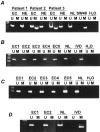hMLH1 promoter hypermethylation is an early event in human endometrial tumorigenesis
- PMID: 10550333
- PMCID: PMC1866976
- DOI: 10.1016/S0002-9440(10)65492-2
hMLH1 promoter hypermethylation is an early event in human endometrial tumorigenesis
Abstract
It has recently been suggested that silencing of the hMLH1 gene by promoter hypermethylation is the mechanism underlying the presence of the microsatellite instability (MSI) phenotype in sporadic colon and endometrial carcinomas. To determine whether hMLH1 promoter hypermethylation is a relatively early event in endometrial tumorigenesis we evaluated endometrial hyperplasia (EH) characterized as simple, complex, and atypical (the direct precursor of endometrial carcinoma) for hMLH1 aberrant methylation. In addition, we studied the hMLH1, hMSH2, hMSH3, and hMSH6 promoter methylation and MSI status of those endometrial carcinomas with synchronous hyperplasias and those without them. We found that 11 of 12 (91%) cases of endometrial carcinoma (EC) displaying MSI had hMLH1 promoter hypermethylation, whereas aberrant methylation of any of the other mismatch repair genes was not observed. All 15 cases of EC without MSI were unmethylated at hMLH1. Abnormal methylation of hMLH1 was also present in 8 of 116 (7%) cases of EH and was restricted primarily to the atypical endometrial hyperplasia (AEH) type with coexisting endometrial carcinoma. In this set, half of EH methylated at hMLH1 displayed MSI, whereas none of the unmethylated EH had MSI. Our data suggest that hypermethylation of hMLH1 can be an early event in the pathogenesis of EC, preceding the development of an apparent MSI phenotype in a subset of cases.
Figures


Comment in
-
hMLH1 promoter hypermethylation in microsatellite instability-positive endometrial carcinoma. Cause or consequence?Am J Pathol. 1999 Nov;155(5):1399-402. doi: 10.1016/S0002-9440(10)65451-X. Am J Pathol. 1999. PMID: 10550292 Free PMC article. No abstract available.
References
-
- Parker SL, Tong T, Bolden S, Wingo PA: Cancer statistics. CA Cancer J Clin 1997, 47:5-27 - PubMed
-
- Sherman A, Brown S: The precursors of endometrial carcinoma. Am J Obstet Gynecol 1979, 135:947-954 - PubMed
-
- Kurman R, Kaminski P, Norris H: The behavior of endometrial hyperplasia: a long term study of “untreated” hyperplasia in 170 patients. Cancer 1985, 56:403-412 - PubMed
-
- Jovanovic AS, Boynton KA, Mutter GL: Uteri of women with endometrial carcinoma contain a histopathological spectrum of monoclonal putative precancers, some with microsatellite instability. Cancer Res 1996, 56:1917-1921 - PubMed
-
- Esteller M, Garcia A, Martinez-Palones JM, Xercavins J, Reventos J: Detection of clonality and genetic alterations in endometrial pipelle biopsy and its surgical specimen counterpart. Lab Invest 1997, 76:109-116 - PubMed
Publication types
MeSH terms
Substances
LinkOut - more resources
Full Text Sources
Other Literature Sources

